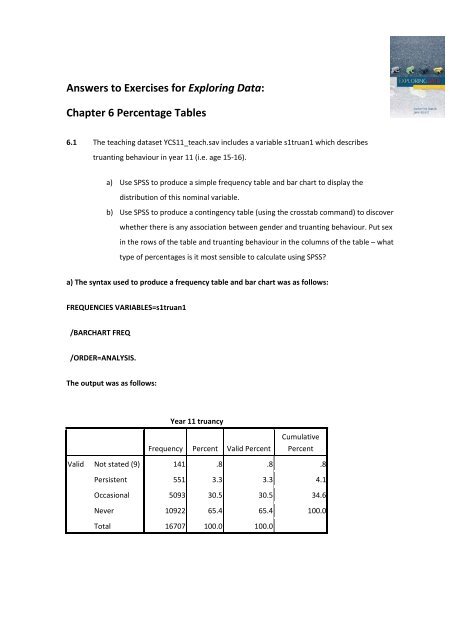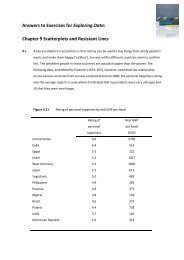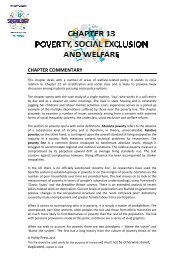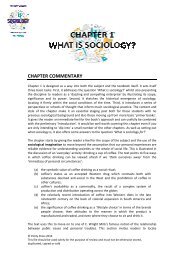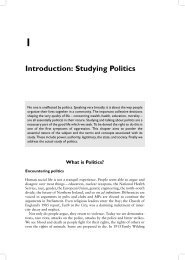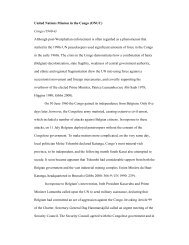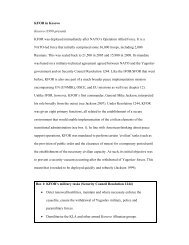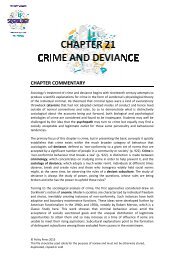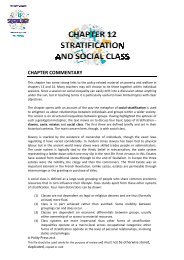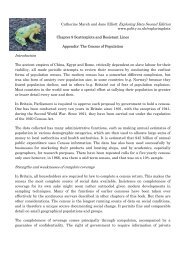Chapter 6 Percentage Tables - Polity
Chapter 6 Percentage Tables - Polity
Chapter 6 Percentage Tables - Polity
You also want an ePaper? Increase the reach of your titles
YUMPU automatically turns print PDFs into web optimized ePapers that Google loves.
Answers to Exercises for Exploring Data:<br />
<strong>Chapter</strong> 6 <strong>Percentage</strong> <strong>Tables</strong><br />
6.1 The teaching dataset YCS11_teach.sav includes a variable s1truan1 which describes<br />
truanting behaviour in year 11 (i.e. age 15‐16).<br />
a) Use SPSS to produce a simple frequency table and bar chart to display the<br />
distribution of this nominal variable.<br />
b) Use SPSS to produce a contingency table (using the crosstab command) to discover<br />
whether there is any association between gender and truanting behaviour. Put sex<br />
in the rows of the table and truanting behaviour in the columns of the table – what<br />
type of percentages is it most sensible to calculate using SPSS?<br />
a) The syntax used to produce a frequency table and bar chart was as follows:<br />
FREQUENCIES VARIABLES=s1truan1<br />
/BARCHART FREQ<br />
/ORDER=ANALYSIS.<br />
The output was as follows:<br />
Year 11 truancy<br />
Frequency Percent Valid Percent<br />
Cumulative<br />
Percent<br />
Valid Not stated (9) 141 .8 .8 .8<br />
Persistent 551 3.3 3.3 4.1<br />
Occasional 5093 30.5 30.5 34.6<br />
Never 10922 65.4 65.4 100.0<br />
Total 16707 100.0 100.0
) In order to produce a contingency table (Crosstab) of sex by truanting behaviour the following<br />
syntax was used:<br />
CROSSTABS<br />
/TABLES=s1sex BY s1truan1<br />
/FORMAT=AVALUE TABLES<br />
/CELLS=COUNT ROW<br />
/COUNT ROUND CELL.
The following table was produced:<br />
Respondent's gender * Year 11 truancy Crosstabulation<br />
Year 11 truancy<br />
Not stated<br />
(9) Persistent Occasional Never Total<br />
Respondent's<br />
gender<br />
Male Count 71 219 2142 5032 7464<br />
% within Respondent's<br />
gender<br />
1.0% 2.9% 28.7% 67.4% 100.0%<br />
Female Count 70 332 2951 5890 9243<br />
% within Respondent's<br />
gender<br />
.8% 3.6% 31.9% 63.7% 100.0%<br />
Total Count 141 551 5093 10922 16707<br />
% within Respondent's<br />
gender<br />
.8% 3.3% 30.5% 65.4% 100.0%<br />
Row percentages are calculated so that it is possible to compare the percentage of boys who are<br />
persistent truants and the percentage of girls who are persistent truants. This table suggests that<br />
girls are more likely than boys to be truants.<br />
6.2 The teaching dataset YCS11_teach.sav also includes a separate variable for mother and<br />
father’s social position measured using NS‐SEC. The table below shows a contingency table<br />
of mother’s social position by father’s social position.
Figure 6.19 SPSS output showing contingency table of mother’s social position by father’s social<br />
position<br />
dadsec father's grouped ns-sec * momsec mother's grouped ns-sec Crosstabulation<br />
dadsec<br />
father's<br />
grouped<br />
ns-sec<br />
1.00 Large employers<br />
and higher professionals<br />
2.00 Lower professional<br />
and higher technical<br />
occupations<br />
Count<br />
% of Total<br />
Count<br />
% of Total<br />
1.00 Large<br />
employers<br />
and higher<br />
2.00 Lower<br />
professional<br />
and higher<br />
technical<br />
momsec mother's grouped ns-sec<br />
3.00<br />
Intermediate<br />
4.00 Lower<br />
supervisory<br />
5.00 Semi<br />
routine and<br />
routine<br />
professionals occupations occupations occupations occupations 6<br />
90 298 184 38 157<br />
1.5% 4.8% 3.0% .6% 2.5%<br />
61 380 235 63 210<br />
1.0% 6.1% 3.8% 1.0% 3.4%<br />
Total<br />
3.00 Intermediate<br />
4.00 Lower supervisory<br />
occupations<br />
5.00 Semi routine and<br />
routine occupations<br />
6.00 Other<br />
Count<br />
% of Total<br />
Count<br />
% of Total<br />
Count<br />
% of Total<br />
Count<br />
% of Total<br />
Count<br />
% of Total<br />
37 215 383 99 292<br />
.6% 3.5% 6.2% 1.6% 4.7%<br />
23 168 138 132 270<br />
.4% 2.7% 2.2% 2.1% 4.4%<br />
13 107 122 95 392<br />
.2% 1.7% 2.0% 1.5% 6.3%<br />
31 202 139 62 302<br />
.5% 3.3% 2.2% 1.0% 4.9%<br />
255 1370 1201 489 1623<br />
4.1% 22.2% 19.4% 7.9% 26.2%<br />
a) What percentage of mothers and fathers are in the same category of NS‐SEC?<br />
The figure of 90 (1.5%) in the top left hand corner of the table indicates that there are 90 mothers<br />
and fathers (from a total of 6184) who are both in the category ‘Large employers and higher<br />
professionals’. Therefore by adding the percentages down the leading diagonal (1.5+ 6.1+6.2+<br />
2.1+6.3+7.5) we obtain 29.7%. This is the percentage of mothers and fathers who are in the same<br />
category of NS‐SEC.<br />
b) What percentage of fathers are in a higher social class position<br />
than their wives/partners and what percentage of mothers are in a<br />
higher social class position than their husbands/partners?<br />
In total 42.4% of fathers are in a higher social class position than their wives/partners and 27.7%<br />
of mothers are in a higher social class than their husbands/partners. This assumes that we treat<br />
the ‘other’ category as being in a lower social class position than the other categories.<br />
c) Check that you can replicate the table using SPSS.
6.3 The following table is adapted from Fiegehan et al. (1977); the authors set out to investigate<br />
both the causes of poverty and the type of social policy that would best alleviate it. In order<br />
to discover whether household size had any effect on poverty, they re‐analysed some data<br />
originally collected for the Family Expenditure Survey, and got a table something like that<br />
shown in figure 6.20.<br />
Figure 6.20<br />
Household size by numbers in poverty<br />
Number in household In poverty Not in poverty Total<br />
1 259 991 1250<br />
2 148 2159 2307<br />
3 45 1319 1364<br />
4 21 1272 1293<br />
5 16 573 589<br />
6 or more 21 324 345<br />
Total 510 6638 7148<br />
Construct two tables running the percentages both ways and say how each table might contribute<br />
to understanding the relationship between poverty and household size. What advice would you give<br />
to a policy‐maker about where to concentrate resources to alleviate poverty on the basis of these<br />
figures?<br />
Number in household Risk of<br />
poverty<br />
Accountability<br />
for poverty<br />
1 20.7 50.8<br />
2 6.4 29.0<br />
3 3.3 8.8<br />
4 1.6 4.1<br />
5 2.7 3.1<br />
6 or more 6.1 4.1<br />
Calculating row percentages provides the risk of poverty for each household size. For example the<br />
risk of being in poverty if you are in a one‐person household is [(259/1250) x 100] because 259 out<br />
of 1250 one‐person households are in poverty. This suggests that it is those in one‐person<br />
households who are at greatest risk of being in poverty. In addition by calculating column<br />
percentages we can see that those in one‐person households account for 50.8% of all households
that are in poverty. Policy makers would therefore be advised to focus resources on<br />
one‐person households.<br />
6.4 The NCDS teaching dataset NCDS_ExpData_teach.sav contains information on the social<br />
class of cohort members at age 46 and the social class of their father when they were aged<br />
16. Construct both an inflow and an outflow mobility table and discuss the results.<br />
By calculating row percentages (with Father’s social class defining the rows) we get an ‘outflow’<br />
table. This shows, for example that of those boys with a father in social class 1 at age 16, 19%<br />
became professionals by age 46 compared with just 4.4% of boys with a manual father. In<br />
contrast, by calculating the column percentages we create an inflow table and discover that 8.5%<br />
of those who are currently in the professional group at age 46 come from a background with a<br />
manual father in social class IV. Arguably the inflow table, with row percentages, gives a better<br />
indication of the level of social mobility for those boys born in 1958. This is because it can be used<br />
to look at the relative chances of boys with different social class backgrounds reaching the<br />
Professional social class by age 46.
3P Social class<br />
father,male<br />
head (GRO<br />
1970) at age 16 I Professional<br />
II Managerialtechnical<br />
(Current Job) Social Class at age 46<br />
IIINM Skilled IIIM Skilled<br />
non‐manual manual IV Partly skilled V Unskilled Others Total<br />
I Count 69 195 48 31 17 2 1 363<br />
% within 3P Social class<br />
father,male head (GRO<br />
1970) at age 16<br />
19.0% 53.7% 13.2% 8.5% 4.7% .6% .3% 100.0%<br />
II Count 116 674 242 139 93 17 3 1284<br />
% within 3P Social class<br />
father,male head (GRO<br />
1970) at age 16<br />
9.0% 52.5% 18.8% 10.8% 7.2% 1.3% .2% 100.0%<br />
III non‐manual Count 41 277 132 107 46 4 3 610<br />
% within 3P Social class<br />
father,male head (GRO<br />
1970) at age 16<br />
6.7% 45.4% 21.6% 17.5% 7.5% .7% .5% 100.0%<br />
III manual Count 88 901 558 559 280 63 1 2450<br />
% within 3P Social class<br />
father,male head (GRO<br />
1970) at age 16<br />
3.6% 36.8% 22.8% 22.8% 11.4% 2.6% .0% 100.0%<br />
IV non‐manual Count 2 39 15 23 18 1 0 98<br />
% within 3P Social class<br />
father,male head (GRO<br />
1970) at age 16<br />
2.0% 39.8% 15.3% 23.5% 18.4% 1.0% .0% 100.0%<br />
IV manual Count 30 239 130 140 117 28 2 686<br />
% within 3P Social class<br />
father,male head (GRO<br />
1970) at age 16<br />
4.4% 34.8% 19.0% 20.4% 17.1% 4.1% .3% 100.0%
V Count 3 76 46 54 43 15 0 237<br />
% within 3P Social class<br />
father,male head (GRO<br />
1970) at age 16<br />
1.3% 32.1% 19.4% 22.8% 18.1% 6.3% .0% 100.0%<br />
Unclear Count 4 30 16 4 11 4 0 69<br />
% within 3P Social class<br />
father,male head (GRO<br />
1970) at age 16<br />
5.8% 43.5% 23.2% 5.8% 15.9% 5.8% .0% 100.0%<br />
Total Count 353 2431 1187 1057 625 134 10 5797<br />
% within 3P Social class<br />
father,male head (GRO<br />
1970) at age 16<br />
6.1% 41.9% 20.5% 18.2% 10.8% 2.3% .2% 100.0%<br />
(Current Job) Social Class at age 46<br />
3P Social class<br />
father,male head<br />
(GRO 1970) at<br />
age 16<br />
I Professional<br />
II Managerialtechnical<br />
IIINM Skilled<br />
non‐manual<br />
IIIM Skilled<br />
manual IV Partly skilled V Unskilled Others Total<br />
I Count 69 195 48 31 17 2 1 363<br />
% within (Current Job) Social<br />
Class at age 46<br />
19.5% 8.0% 4.0% 2.9% 2.7% 1.5% 10.0% 6.3%<br />
II Count 116 674 242 139 93 17 3 1284<br />
% within (Current Job) Social<br />
Class at age 46<br />
32.9% 27.7% 20.4% 13.2% 14.9% 12.7% 30.0% 22.1%<br />
III non‐manual Count 41 277 132 107 46 4 3 610<br />
% within (Current Job) Social<br />
Class at age 46<br />
11.6% 11.4% 11.1% 10.1% 7.4% 3.0% 30.0% 10.5%
III manual Count 88 901 558 559 280 63 1 2450<br />
% within (Current Job) Social<br />
Class at age 46<br />
24.9% 37.1% 47.0% 52.9% 44.8% 47.0% 10.0% 42.3%<br />
IV non‐manual Count 2 39 15 23 18 1 0 98<br />
% within (Current Job) Social<br />
Class at age 46<br />
.6% 1.6% 1.3% 2.2% 2.9% .7% .0% 1.7%<br />
IV manual Count 30 239 130 140 117 28 2 686<br />
% within (Current Job) Social<br />
Class at age 46<br />
8.5% 9.8% 11.0% 13.2% 18.7% 20.9% 20.0% 11.8%<br />
V Count 3 76 46 54 43 15 0 237<br />
% within (Current Job) Social<br />
Class at age 46<br />
.8% 3.1% 3.9% 5.1% 6.9% 11.2% .0% 4.1%<br />
Unclear Count 4 30 16 4 11 4 0 69<br />
% within (Current Job) Social<br />
Class at age 46<br />
1.1% 1.2% 1.3% .4% 1.8% 3.0% .0% 1.2%<br />
Total Count 353 2431 1187 1057 625 134 10 5797<br />
% within (Current Job) Social<br />
Class at age 46<br />
100.0% 100.0% 100.0% 100.0% 100.0% 100.0% 100.0% 100.0%


